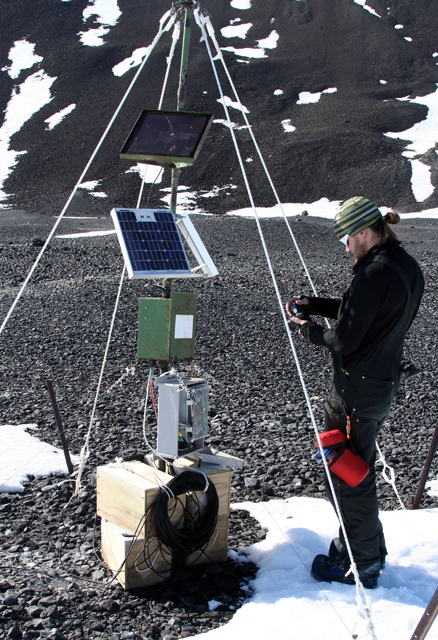Added protection
Revised ASPA plan for Cape Hallett preserves huge Adélie colony
Posted April 16, 2010
The journey required the support of a nearby Italian research station, Terra Nova, and a couple of extra nights stuck in a “bare bones” tent camp thanks to the continent’s unpredictable weather.
“Getting out to Hallett is very difficult because it is so far away [from McMurdo Station],” said Pettway, the lead environmental specialist at Raytheon Polar Services Co. (RPSC)
Site of a former joint U.S. and New Zealand research station, Cape Hallett is home to a huge colony of Adélie penguins, and a diverse range of lichens, moss and tiny invertebrates. It’s also become a new model for how the U.S. Antarctic Program (USAP)
Cape Hallett first gained special protection under the Antarctic Treaty
Pettway and his three-person team spent a week at Cape Hallett to redefine the ASPA boundaries and to survey the various animal populations. The USAP plans to submit a revised ASPA plan for Cape Hallett at the next meeting of the member nations to the Antarctic Treaty in
“We probably did the most thorough site assessment of an ASPA that’s been done,” said Nate Biletnikoff, manager of RPSC’s environmental engineering department. RPSC provides much of the logistical support for the USAP, which is managed by the National Science Foundation (NSF)
RPSC hired a subcontractor, Environmental Research & Assessment (ERA)
“We basically surveyed the entire area,” Biletnikoff said. “This is first time we’ve ever surveyed the spatial extent of a penguin colony to this level of detail.”
Tourism is partly the reason behind the detailed survey, according to Biletnikoff. The International Association of Antarctic Tour Operators

Photo Credit: Jessie Jenkins
The Italian Antarctic program assisted the USAP environmental team with helicopter support.
While environmental protection has long been a fixture in the management of Antarctica, people have not always treaded so lightly on the continent. The original establishment of Cape Hallett Station on a site dubbed Seabee Hook in 1956 involved the “eviction” of more than 7,500 penguins, including some 3,300 chicks, to clear space for construction.
The colony declined from 62,900 pairs in 1959 to a low of 37,000 pairs in 1968. It has since recovered its former numbers and has started to re-occupy the site of the station, which ceased operations in 1973. The area itself has been cleaned up, and the last structures removed by the Italians in January 2010. Many of the historical artifacts from the station are located at the
“The colony just keeps creeping forward. [ERA is] anticipating that the colony will fill into the coastline for the most part,” Biletnikoff said.
The new site map for tourist access proposes additional landing sites for boats, he said, to help minimize disturbances to the colony by ensuring operators come ashore at recognizable landmarks.
By the Numbers
Square kilometers of updated Cape Hallett ASPA: 0.53 square kilometers
Adélie penguins: 64,000 breeding pairs
South polar skuas: About 232 birds and 250 numbered nests
Other wildlife in the region: Emperor penguins, chinstrap penguins, Wilson’s storm petrels, snow petrels, southern giant petrels, Weddell seals, leopard seals and minke whales.
Number of invertebrates: Eight species of mites and three species of springtails
Vegetation: Five species of moss and 18 lichens
Total ASPA sites: 71
Number of ASPA sites under U.S. management: 13
Adélie penguins: 64,000 breeding pairs
South polar skuas: About 232 birds and 250 numbered nests
Other wildlife in the region: Emperor penguins, chinstrap penguins, Wilson’s storm petrels, snow petrels, southern giant petrels, Weddell seals, leopard seals and minke whales.
Number of invertebrates: Eight species of mites and three species of springtails
Vegetation: Five species of moss and 18 lichens
Total ASPA sites: 71
Number of ASPA sites under U.S. management: 13
The ASPA plan also includes a smaller
“That was difficult — figuring out where it was and moving the rocks without disturbing the moss and lichens,” he said.
The environmental team also played scientist on behalf of several researchers who have interests in the ecosystem. For instance, they counted penguins and eggs for David Ainley
“It was a lot harder to count penguins than you would think,” said Pettway, who, along with Jessie Jenkins, field center supervisor, spent most of the week tallying penguins, skuas and seals.
He also repaired an automatic weather station for the
“It goes beyond the ASPA management plan. We helped Ainley out. We helped Antarctica New Zealand out. … There are a lot of other things that we did out there,” Biletnikoff noted.
Source





















No comments:
Post a Comment